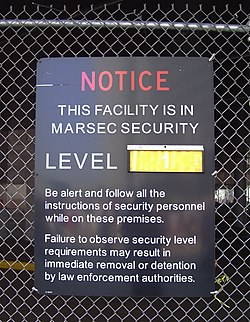
MARSEC (MARitime SECurity) is the North American three-tiered Maritime Security system (alert state). It is used by both Canada and United States. United States Coast Guard designed it to easily communicate to the Coast Guard and the maritime industry pre-planned scalable responses for credible threats. Its objective is to provide an assessment of possible terrorist activity within the maritime sectors of transportation, including threats to nautical facilities and vessels falling within the jurisdiction of the United States and Canada that could be targets of attack.
Contents
The Coast Guard originally created MARSEC to be compatible with, and respond in unison to the Department of Homeland Security’s (DHS) Homeland Security Advisory System (HSAS). With the introduction of the National Terrorism Advisory System (NTAS) to replace HSAS, the Commandant of the Coast Guard will adjust the MARSEC Level, if appropriate, based on any NTAS Alert issued by DHS. As of 2005, Transport Canada also uses MARSEC levels as legislated in the Marine Transportation Security Regulations. [1]